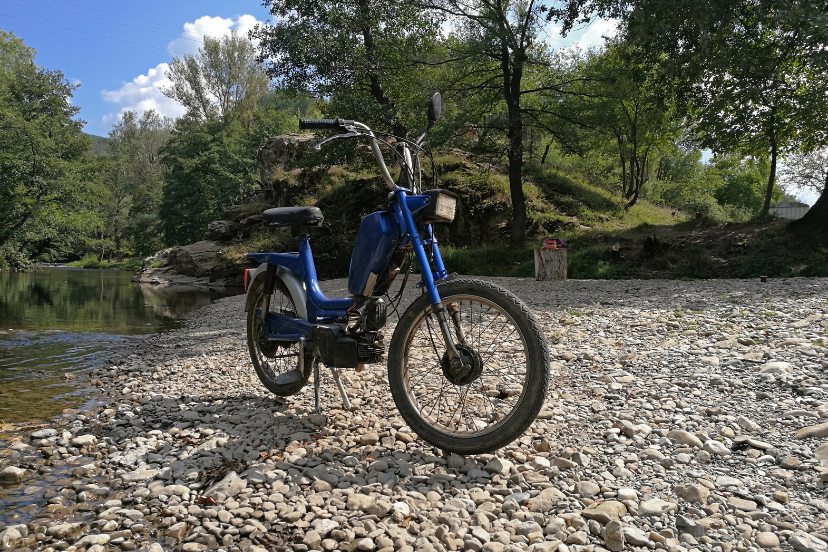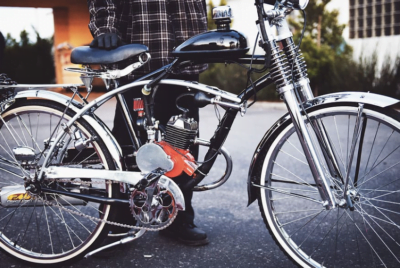Understanding the Basics of a 4-Stroke Bicycle Engine Kit
Cycling is not just a sport or leisure activity but a lifestyle. For some, it’s about the thrill of speed and the wind in their hair. For others, it’s about the freedom to explore and the joy of self-propelled travel. But what if you could combine the best of both worlds? Enter the 4-stroke bicycle engine kit. This article will delve into a 4-stroke bicycle engine kit’s basics, components, advantages, installation, and maintenance. We will cover:
- The Mechanics of a 4-Stroke Engine
- The Components of a 4-Stroke Engine
- Advantages of a 4-Stroke Engine
- How to Install a 4-Stroke Bicycle Engine Kit
- Maintenance Tips for a 4-Stroke Bicycle Engine Kit
I. Introduction
Bicycles have been a staple of personal transportation for over a century. They’re simple, efficient, and offer a great way to get exercise. But sometimes, you need a little extra power. That’s where a 4-stroke engine comes in. These kits allow you to transform your regular bicycle into a motorized bike, giving you the power to tackle hills and long distances with ease.
A 4-stroke bicycle engine kit is a set of components you can install on your bicycle to convert it into a motorized bike. These kits are popular among cyclists who want to use an engine for longer rides or when carrying heavy loads. They’re also great for people who want to get into cycling but need to be more confident with the physical effort required.
A. Brief Overview of 4-Stroke Bicycle Engine Kits
A 4-stroke bicycle engine kit is a type of motorized bike kit that uses a 4-stroke engine. Unlike 2-stroke engines, which complete a power cycle in two strokes of the piston, 4-stroke engines complete the same cycle in four strokes. This makes them more efficient and quieter than their 2-stroke counterparts. They’re also easier to maintain and have a longer lifespan.
II. The Mechanics of a 4-Stroke Engine
Understanding how a 4-stroke engine works can help you maximize its capabilities. It can also assist you in troubleshooting any issues that may arise during its use.
A. What is a 4-Stroke Engine?
A 4-stroke engine, also known as a four-cycle engine, is an internal combustion engine that completes four separate strokes—intake, compression, combustion, and exhaust—during two revolutions of the engine’s crankshaft. This type of engine is commonly used in cars, motorcycles, and, of course, motorized bicycles.
B. How Does a 4-Stroke Engine Work?
The operation of a 4-stroke engine begins with the intake stroke, where the piston moves down the cylinder, creating a vacuum that draws in air and fuel. Next is the compression stroke, where the piston moves back up the cylinder, compressing the air-fuel mixture. The third stroke is the combustion stroke, where the compressed air-fuel mixture is ignited by a spark, causing it to explode and push the piston down. Finally, the exhaust stroke occurs, where the piston moves back up to expel the combustion gases from the cylinder. This cycle then repeats.
III. The Components of a 4-Stroke Bicycle Engine Kit
A 4-stroke bicycle engine kit typically includes several key components that combine to convert your bicycle into a motorized bike. Understanding these components can help you install and maintain your kit more effectively.
A. Engine
The engine is the heart of the kit. It’s a small 4-stroke engine, usually between 49cc and 150cc. This engine is responsible for generating the power that propels your bicycle. It’s typically mounted to the bicycle frame and connected to the rear wheel with a chain or belt.
B. Carburetor
The carburetor is a device that mixes air and fuel for the engine. It’s crucial for the engine’s performance and efficiency. The carburetor is typically connected to the engine’s intake manifold and the air filter.
C. Exhaust
The exhaust system includes the exhaust pipe and the muffler. It’s responsible for directing the combustion gases away from the engine and reducing the noise produced by the engine’s exhaust gases.
D. Transmission
The transmission is a system of gears that transfers power from the engine to the rear wheel. It allows the engine to operate in its optimal power range while providing a wide range of speeds for the bicycle.
E. Fuel Tank
The fuel tank stores the gasoline that the engine uses for combustion. It’s typically mounted above the engine or on the bicycle frame.
F. Throttle and Clutch Control
The throttle control allows you to regulate the engine’s speed, while the clutch control engages and disengages the engine’s power to the rear wheel. These controls are usually mounted on the bicycle’s handlebars for easy access.
IV. Advantages of a 4-Stroke Bicycle Engine
Installing a 4-stroke bicycle engine kit on your bicycle can provide several benefits. These advantages make these kits a popular choice among many cyclists.
A. Fuel Efficiency
4-stroke engines are more fuel-efficient than 2-stroke engines. They use every crankshaft revolution to produce power, resulting in less wasted fuel. This means you can travel further on a single tank of gas.
B. Power and Torque
4-stroke engines provide a good balance of power and torque, making them suitable for a wide range of cycling conditions. Whether climbing steep hills or cruising on flat roads, a 4-stroke engine can provide your needed power.
C. Durability and Longevity
4-stroke engines are generally more durable and longer-lasting than 2-stroke engines. They have a more complex design with separate oil and fuel systems, which helps reduce wear and tear on the engine components.
V. How to Install a 4-Stroke Bicycle Engine Kit
Installing a 4-stroke bicycle engine kit on your bicycle can be a rewarding project. You can transform your regular bicycle into a powerful motorized bike with some essential tools and patience.
A. Tools Needed
You’ll need some basic tools to install a 4-stroke bicycle engine. These typically include a set of wrenches, a screwdriver, a drill, and a bicycle stand.
B. Step-by-Step Installation Guide
The installation process involves:
- Mounting the engine to your bicycle frame.
- Installing the transmission and exhaust system.
- Connecting the fuel tank and carburetor.
- Setting up the throttle and clutch controls.
- Following the manufacturer’s instructions carefully ensures a safe and successful installation.
VI. Maintenance Tips for a 4-Stroke Bicycle Engine Kit
Proper maintenance is critical to keeping your 4-stroke bicycle engine kit running smoothly and reliably. Here are some tips to help you keep your motorized bike in shape.
A. Regular Check-ups
Regularly inspect your engine and its components for any wear or damage. Check the fuel and oil levels, inspect the spark plug, and ensure all bolts and connections are tight.
B. Cleaning and Lubrication
Keep your engine clean and well-lubricated to ensure it runs smoothly. Clean the air filter regularly, change the oil as recommended by the manufacturer, and lubricate the chain and other moving parts.
C. Troubleshooting Common Issues
If you encounter any issues with your engine, such as difficulty starting, poor performance, or unusual noises, it’s important to troubleshoot them promptly. Consult your engine kit’s manual or seek professional help if necessary.
VII. Conclusion
A 4-stroke bicycle engine kit can transform your cycling experience, providing the power and speed to tackle any terrain. By understanding the basics of these kits, you can make an informed decision and get the most out of your motorized bicycle.
A. Recap of the Basics of a 4-Stroke Bicycle Engine Kit
This article covers the basics of a 4-stroke bicycle engine kit, including its mechanics, components, advantages, installation, and maintenance. Whether you’re a cycling enthusiast looking to add power to your ride or a beginner seeking a more accessible way to get into cycling, a 4-stroke bicycle engine kit could be an excellent investment.
Throughout this article, we’ve linked to several other resources on our blog to help you further understand and enjoy your cycling journey. From the benefits of wearing a cycling vest to the latest innovations in Adidas cycling shoes, and even a guide to carb cycling meal plans for those looking to optimize their nutrition for cycling. We’ve also included a comprehensive guide to mountain bike helmets and a buyer’s guide for women’s cycling shoes to ensure you’re well-equipped for safety and comfort on your rides.
FAQs
1. What is a 4-stroke bicycle engine kit?
A 4-stroke bicycle engine kit is a set of components you can install on your bicycle to convert it into a motorized bike. It uses a 4-stroke engine, which is more efficient and quieter than a 2-stroke engine.
2. What are the components of a 4-stroke bicycle engine kit?
A 4-stroke bicycle engine kit typically includes an engine, a carburetor, an exhaust system, a transmission, a fuel tank, and throttle and clutch controls.
3. What are the advantages of a 4-stroke bicycle engine kit?
4-stroke bicycle engine kits are more fuel-efficient, provide a good balance of power and torque, and are generally more durable and longer-lasting than 2-stroke engine kits.
4. How do I install a 4-stroke bicycle engine kit?
Installation involves:
- Mounting the engine to your bicycle frame.
- Installing the transmission and exhaust system.
- Connecting the fuel tank and carburetor.
- Setting up the throttle and clutch controls.
- You’ll need some essential tools, and following the manufacturer’s instructions is vital.
5. How do I maintain a 4-stroke engine?
Regular maintenance includes:
- Inspecting your engine and its components for any signs of wear or damage.
- Checking the fuel and oil levels.
- Cleaning the air filter.
- Changing the oil as recommended by the manufacturer.
- Lubricating the chain and other moving parts.
6. Can I install a 4-stroke bicycle engine kit on any bicycle?
Most 4-stroke bicycle engine kits are designed to fit a wide range of bicycles, but it’s always a good idea to check the kit’s and your bike’s specifications to ensure compatibility.
7. Do I need a special license to ride a bicycle with a 4-stroke engine kit?
Laws vary by location, so checking with your local authorities is important. No special license is required in many places as long as the engine is below a certain size (usually 50cc).



